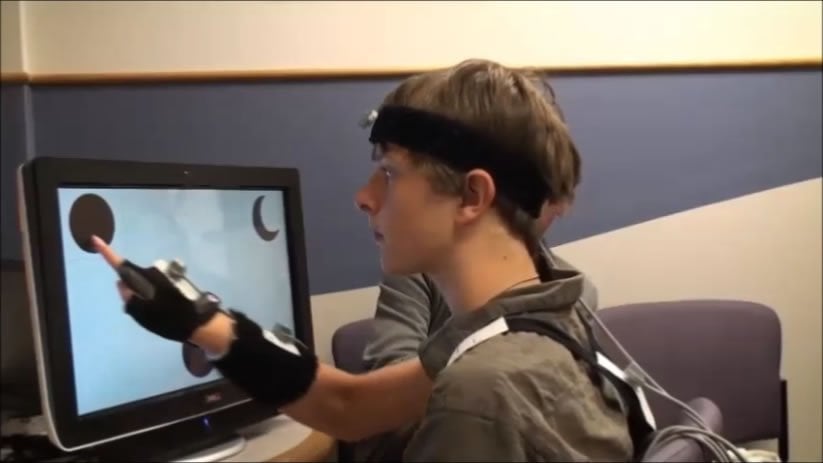Researchers at Indiana University School of Medicine and Rutgers University have developed a new quantitative screening method for diagnosing and longitudinal tracking of autism in children after age 3. The studies are published as part of a special collection of papers in the open-access journal Frontiers in Neuroscience titled “Autism: The Movement Perspective.”
The technique involves tracking a person’s random movements in real time with a sophisticated computer program that produces 240 images a second and detects systematic signatures unique to each person. The traditional assessment for diagnosing autism involves primarily subjective opinions of a person’s social interaction, deficits in communication, and repetitive and restricted behaviors and interests.
The new screening tool is a collaboration between Jorge V. José, Ph.D., vice president of research at Indiana University and the James H. Rudy Distinguished Professor of Physics in the IU Bloomington College of Arts and Sciences; Elizabeth Torres, Ph.D., the principal investigator for the study and an assistant professor in the Department of Psychology in the School of Arts and Sciences at Rutgers University; and Dimitri Metaxas, Ph.D., a Distinguished Professor of computer science at Rutgers. The research was funded by a $670,000 grant from the National Science Foundation.

“This research may open doors for the autistic community by offering the option of a dynamic diagnosis at a much earlier age and possibly enabling the start of therapy sooner in the child’s development,” said Dr. José, who also is a professor of cellular and integrative physiology at the Indiana University School of Medicine.
The new technique provides an earlier, more objective and more accurate diagnosis of autism. It factors the importance of changes in movements and movement sensing, thus enabling the identification of inherent capabilities in each child, rather than just highlighting impairments of the child’s movement systems. It measures tiny fluctuations in movement as the individual moves through space and can determine the exact degree to which these patterns of motion differ from more typically developing individuals, and to what degree they can turn into predictive, reliable and anticipatory movements.
Even in nonverbal children and adults with autism, the method can diagnose autism subtypes, identify gender differences and track individual progress in development and treatment. The method may also be applied to infants.
Dr. José said statistical properties of how people move and the speed and random nature of the movements produce a quantitative measurement that can be applied to individuals when the new technology captures their movements.
“We can estimate the cognitive abilities of people just from the variability of how they move,” Dr. José said. “This may lead to a complementary way to develop therapies for autistic children at an early age.”
In a second paper in the collection, the new method can be applied to interventions. The researchers say it could change the way autistic children learn and communicate by helping them develop self-motivation, rather than relying exclusively on external cues and commands, which are the basis of behavioral therapy for children with autism.
Torres and her team created a digital set-up that works much like a Wii. Children with autism were exposed to onscreen media — such as videos of themselves, cartoons, a music video or a favorite TV show — and learned to communicate what they like with a simple motion.
“Every time the children cross a certain region in space, the media they like best goes on,” Dr. Torres said. “They start out randomly exploring their surroundings. They seek where in space that interesting spot is which causes the media to play, and then they do so more systematically. Once they see a cause and effect connection, they move deliberately. The action becomes an intentional behavior.”
Researchers found that all 25 children in the study, most of whom were nonverbal, spontaneously learned how to choose their favorite media. They also retained this knowledge over time even without practice.
The children independently learned that they could control their bodies to convey and procure what they want. “Children had to search for the magic spot themselves,” Dr. Torres said. “We didn’t instruct them.”
Torres believes that traditional forms of therapy, which place more emphasis on socially acceptable behavior, can actually hinder children with autism by discouraging mechanisms they have developed to cope with their sensory and motor differences, which vary greatly from individual to individual.
It is too early to tell whether the research will translate into publicly available methods for therapy and diagnosis, Dr. Torres said. But she is confident that parents of children with autism would find it easy to adopt her computer-aided technique to help their children.
Notes about this autism research
The co-principle investigators in the study on the clinical side are Indiana University faculty John I. Nurnberger, M.D., Ph.D., the Joyce and Iver Small Professor of Psychiatry and director of the Institute of Psychiatric Research; and Kimberly A. Stigler, M.D., assistant professor of psychiatry and director of the Christine Sarkin Autism Center.
Contact: Mary Hardin – Indiana University School of Medicine
Source: Indiana University School of Medicine press release
Image Source: The image of a child taking the autism test is credited to Rutgers University and is adapted from the Indiana University School of Medicine press release.
Video Source: The video “Motion studies show promise to increase autonomy in children with autism” is available at the IUSMCommunications YouTube page.
Original Research: Full open access research for “Autism: the micro-movement perspective” by Elizabeth B. Torres, Maria Brincker, Robert W. Isenhower, Polina Yanovich, Kimberly A. Stigler, John I. Nurnberger, Dimitris N. Metaxas and Jorge V. José in Frontiers in Neuroscience. Published online July 24 2013 doi: 10.3389/fnint.2013.00032







